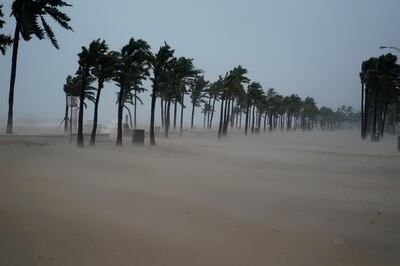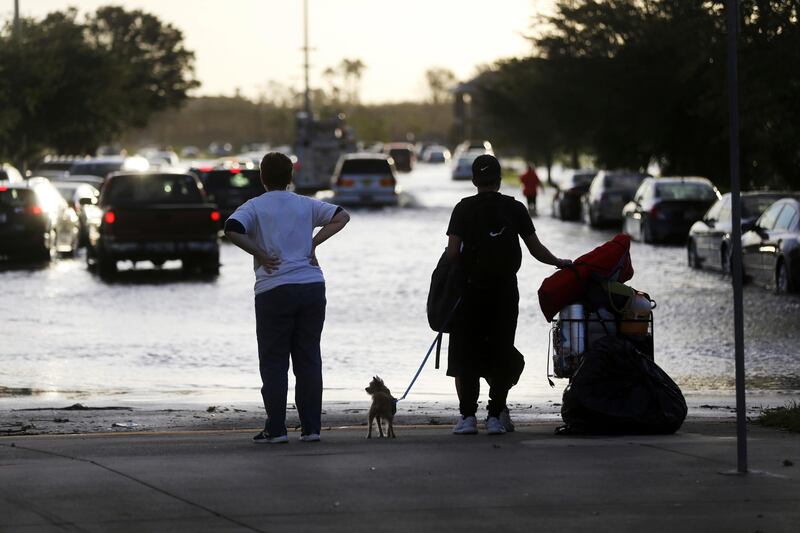Hurricane Irma was at her dangerous worst, snapping trees like toothpicks and spinning tornadoes across land and sea, when Judy Johnson could take it no more. A veteran of countless Florida hurricanes, she had chosen to ride out the storm in her 13-tonne trailer but the battering had become too much even for her to bear.
She dived into her 4x4 and drove for the highway, hoping she could find a safe spot at a truck stop.
“It was terrifying but I didn’t know what else to do,” she said a day later.
She made the five kilometres to the turnpike. But then disaster struck. As the road took her to exposed ground, the 150kph gusts were too simply too much. The bonnet of her car slammed open, smashing into the windscreen.
“The police saw me driving along at about 10mph [16kph] and just told me someone was going to crash into me,” she said.
They turned her back. She had no option but to return to the recreation vehicle she had fled.
“It was going from side to side. And I have a big rig,” she said.
“I don’t know how anyone else managed.”
Our reporter Rob Crilly, who was on lockdown in Fort Lauderdale during #HurricaneIrma, has spent today inspecting the damage done by the storm and talking to local residents who now have to pick up the pieces following the extreme weather.
Posted by The National on Monday, September 11, 2017
She stayed inside for a terrifying 12 hours, not knowing if one of the trailer park’s 20-metre trees was about to come smashing down on her home or one of the lighter trailers would be tossed by a tornado.
A handful of residents stayed at the park on the outskirts of Fort Lauderdale. They had no family to turn to and the local hotels were either full or shut because of mandatory evacuation orders.
Huddled at the back of her vehicle, away from the glass windows of its sitting room, Ms Johnson, a retired postal worker, contemplated her own mortality.
“Even if you’re used to it, sometimes you still remember you can die,” she said.
A day later she surveyed her trailer for damage. Part of its refrigerator unit, mounted on the roof, had been lifted off. Her battered 4x4 would need a new windscreen. Branches littered the ground along with thin roofing shingles.
But otherwise her life and her home were remarkably intact.
“If it had been a little bit closer over,” she said, her lively Floridian accent quieting briefly, “I don’t know how we would have survived.”

As the people of Fort Lauderdale came out on Monday morning, that sentiment was widespread. It was a case of what might have been.
Irma had taken a last minute tack to the west before hitting the Florida mainland. The big cities of Miami and Fort Lauderdale missed the very worst of her fury. Instead her 250kph winds battered the empty Everglades before moving north into Naples and Fort Myers.
But her 600km width meant the damage spread from devastated coast to coast.
Fort Lauderdale, on the north-east fringe of Irma’s counter-clockwise winds, was hit by at least three tornadoes as storms spiralled off its front. Winds remained dangerous throughout Sunday and into Monday. Two cranes were brought crashing down in Miami and one in Fort Lauderdale.
Rain flooded roads and low-lying buildings.
Almost six million people were without power by Monday morning and five deaths had been reported, including one in Key West, which bore the brunt of the storm a day earlier.
Irma continued to push north but it was downgraded to a tropical storm with winds of about 100kph as it headed for Georgia.
On Florida's west coast, cities suffered flooding from a storm surge. The National Weather Service said Jacksonville had suffered a surge that exceeded the 1964 record set by Hurricane Dora.
Bob Buckhorn, the mayor of Tampa Bay, said the situation was not as bad as it could have been, but warned residents that the danger from storm surges continued.
“What we feared the most was the surge," he said on MSNBC. "The surge is yet to be finished."
President Donald Trump has approved a major disaster declaration and emergency aid for Florida, describing the hurricane as a "big monster".
“These are storms of catastrophic severity and we are marshalling the full resources of the federal government to help our fellow Americans,” he said during a 9/11 remembrance ceremony at the Pentagon. “When Americans are in need, Americans pull together and we are one country.”
Rick Scott, the governor of Florida, was due to travel to the Florida Keys to assess damage there. Irma made land at Cudjoe Key as a category four hurricane with sustained winds as high as 215kph.
Authorities on the island chain must check the integrity of 42 bridges linking the islands to each other and to the mainland.
The Cuban government reported that 10 people were killed when Irma battered the island's north coast with 11-metre waves over the weekend, putting the overall death toll for the hurricane’s path through the Caribbean at 38.
Officials in Miami admitted that the toll further south showed how the east coast of the mainland dodged the worst of the storm fury.
Ken Russell, a Miami city commissioner, said: “It’s a story of resilience and luck. Our heart goes out to the islands to the south of us.”
Fort Lauderdale, which had been under curfew for almost 48 hours, gradually came back to life as the storm clouds lifted and the sun appeared for the first time in two days.
Business owners began removing boards from their stores, residents cleared tree branches from their driveways and floodwaters drained away.
However, authorities were keen to remind residents that dangers remain.
Sheriff’s deputies shut down one of the main crossings to the city’s barrier island, which serves as both flood defence and site of some of the most desirable homes.
“There are power lines down there. We don’t want anyone lighting up,” warned one officer,
Traffic lights had also failed across the city, raising the risk of road accidents, he added.
“We are asking everyone to treat these junctions as if they were four-way stops, but plenty of people are driving like idiots.”
And then there are the looters. Even before the winds subsided, a gang was caught on camera smashing their way into a sportswear store before emerging with handfuls of clothing and shoes. They were spotted at two more stores before police caught up with them, arresting six adults and three teenagers.
“Going to prison over a pair of sneakers is a fairly bad life choice,” said Rick Maglione, Fort Lauderdale chief of police. “Stay home and look after your loved ones and be thankful they are all safe."
Elsewhere in the county, a teenager was shot by a police officer and a second was arrested after they were caught burgling an empty home. Police were alerted by the owners who were sheltering inland but saw the intruders on their home security cameras.
In all, more than two dozen suspected looters have been caught in Fort Lauderdale and Miami.
It means an anxious wait for homeowners trying to return to their property.
Alex Arandia, an attorney from New York, had sheltered with this wife, daughter and nanny at a school in Davie, a few miles to the west. On Monday morning, he was still unable to get to his beachfront home where police officers had closed the road.
He had only bought the property a month ago and had been visiting to furnish it as a holiday home.
At first he planned to ride out the storm but when locals started leaving town he realised it was too dangerous to stay.
“Our concern was the water,” he said. “If we had the storm surge we might have ended up just having to tear the place down.”
Now he just faces an anxious wait to find out how much damage was done.
“God was kind,” he said.






